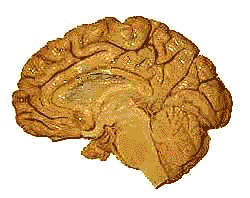Neuroscience For Kids
The Brain: Right Down the Middle
 | Although some people may think that the brain is like a bowl of Jell-O, the brain is NOT a bowl of jell-O. Unlike a bowl of Jell-O, the brain is not a uniform material. Rather, the brain is made up of many different areas, each having a particular structure and function. The "midsagittal plane" separates the brain into right and left hemispheres. |
Midsaggital Plane

| Brain Structures | |
| Cerebral Cortex Functions:
|
 The word "cortex" comes
from the Latin word for "bark" (of a tree). This is because the cortex is
a sheet of tissue that makes up the outer layer of the brain. The
thickness of the cerebral cortex varies from 2 to 6 mm. The right and
left sides of the cerebral cortex are connected by a thick band of nerve
fibers called the "corpus
callosum". In higher mammals like humans, the cerebral cortex looks
like it has many bumps and grooves. A bump or bulge on the cortex is
called a gyrus (the plural of the word gyrus is "gyri") and a groove is
called a sulcus (the plural of the word sulcus is "sulci"). Lower mammals
like rats and mice have very few gyri and sulci. The word "cortex" comes
from the Latin word for "bark" (of a tree). This is because the cortex is
a sheet of tissue that makes up the outer layer of the brain. The
thickness of the cerebral cortex varies from 2 to 6 mm. The right and
left sides of the cerebral cortex are connected by a thick band of nerve
fibers called the "corpus
callosum". In higher mammals like humans, the cerebral cortex looks
like it has many bumps and grooves. A bump or bulge on the cortex is
called a gyrus (the plural of the word gyrus is "gyri") and a groove is
called a sulcus (the plural of the word sulcus is "sulci"). Lower mammals
like rats and mice have very few gyri and sulci. |
Cerebellum
Functions:
|
 The word "cerebellum"
comes from the Latin word for "little brain." The cerebellum is located
behind the brain stem. In some ways, the cerebellum is a bit like the
cerebral cortex: the cerebellum is divided into hemispheres and has a
cortex that surrounds these hemispheres. The word "cerebellum"
comes from the Latin word for "little brain." The cerebellum is located
behind the brain stem. In some ways, the cerebellum is a bit like the
cerebral cortex: the cerebellum is divided into hemispheres and has a
cortex that surrounds these hemispheres. |
Brain stem Functions:
|
 The brain stem is a
general term for the area of the brain between the thalamus and spinal
cord. Structures within the brain stem include the medulla, pons, tectum,
reticular formation and tegmentum. Some of these areas are responsible
for the most basic functions of life such as breathing, heart rate and
blood pressure. The brain stem is a
general term for the area of the brain between the thalamus and spinal
cord. Structures within the brain stem include the medulla, pons, tectum,
reticular formation and tegmentum. Some of these areas are responsible
for the most basic functions of life such as breathing, heart rate and
blood pressure. |
Hypothalamus Functions:
|
 The hypothalamus is
composed of several different areas and is located at the base of the
brain. It is only the size of a pea (about 1/300 of the total brain
weight), but it is responsible for some very important behaviors. One
important function of the hypothalamus is the control of body temperature.
The hypothalamus acts as like a "thermostat" by sensing changes in body
temperature and then sending out signals to adjust the temperature. For
example, if you are too hot, the hypothalamus detects this and then sends
out a signal to expand the capillaries in your skin. This causes blood to
be cooled faster. The hypothalamus also controls the pituitary. The hypothalamus is
composed of several different areas and is located at the base of the
brain. It is only the size of a pea (about 1/300 of the total brain
weight), but it is responsible for some very important behaviors. One
important function of the hypothalamus is the control of body temperature.
The hypothalamus acts as like a "thermostat" by sensing changes in body
temperature and then sending out signals to adjust the temperature. For
example, if you are too hot, the hypothalamus detects this and then sends
out a signal to expand the capillaries in your skin. This causes blood to
be cooled faster. The hypothalamus also controls the pituitary. |
Thalamus Functions:
|
 The thalamus receives
sensory information and relays this information to the cerebral cortex.
The cerebral cortex also sends information to the thalamus which then
transmits this information to other areas of the brain and spinal
cord. The thalamus receives
sensory information and relays this information to the cerebral cortex.
The cerebral cortex also sends information to the thalamus which then
transmits this information to other areas of the brain and spinal
cord. |
 Hear IT! |
Cerebellum | Corpus Callosum | Cortex | Hypothalamus | Thalamus |
- Check out the glossary for definitions of other brain areas.
Copyright © 1996-2017, Eric H. Chudler All Rights Reserved.
